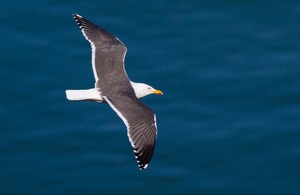Extension of seabird haven to benefit 15,000 birds
Expansion of a protected area in the Isles of Scilly.

The Isles of Scilly supports a greater diversity of seabirds than any other site in England, with internationally important populations of seabirds, including the lesser black-backed gull
Today (17 November), the government has announced the expansion of a protected area in the Isles of Scilly, home to some of our rarest seabirds such as the Manx shearwater and storm petrel.
This decision is based on extensive work by Natural England with a comprehensive package of over 4 years of scientific advice and research on the new boundaries and a public consultation which took place in early spring 2019.
The Isles of Scilly supports a greater diversity of seabirds than any other site in England, with internationally important populations of European storm petrel and lesser black-backed gull. The expansion will see the site boosted by approximately 12,930 hectares and benefit 15,000 seabirds. It is one of only two protected sites in England where Manx shearwater and European storm petrel breed, and is also home to the largest population of great black-backed gulls in the UK.
Our seabird populations are an important barometer of the health of the marine environment and this marine extension to the Isles of Scilly site demonstrates the UK Government’s commitment to securing the sustainable use of our seas.
With the expansion of the Isles of Scilly site into the coastal seas around the archipelago, there are now 114 Marine Protected Areas (MPAs) specifically protecting birds across the UK. The newly-expanded site protects the waters around the islands for activities like feeding and preening that are crucial to the life cycles of over 15,000 seabirds.
Environment Minister Rebecca Pow said:
The UK seabird population is of global importance with the UK holding more than a quarter of Europe’s breeding seabirds. The expansion of this site demonstrates our ongoing commitment to protect and improve the resilience of our marine environment and precious wildlife.
Together with the development of our Seabird Conservation Strategy, we will help the coastal environment to recover and thrive for future generations to enjoy.
Kate Sugar, Marine Lead Adviser at Natural England, said:
The Isles of Scilly is one of the most important areas for breeding seabirds in England and their continued presence is important to the sense of place for the local community and visitors.
These inshore waters are just as important to protecting breeding seabirds as the nesting sites themselves. Natural England’s public consultation on the proposals for this site enabled the local community to understand the evidence collected, the importance and implications of the designation.
Today’s announcement secures greater protection for thousands of seabirds and is a positive step forward as we continue to protect and enhance Britain’s sea and shorebirds.
The expansion of the site will help encourage population growth and recovery in European storm petrel and the lesser black-backed gull, while additionally offering new protections for the European shag and the great black-backed gull.
This MPA forms part of the UK’s ‘Blue Belt’ in helping to boost resilience to man-made pressures, as well as providing space to help species adapt to the impacts of climate change.
There are now 358 MPAs in total across the UK. Regulators, such as the Marine Management Organisation and local Inshore Fisheries and Conservation Authorities (IFCAs), are responsible for ensuring the MPAs are managed to protect their species and habitats, working with local fishing communities and other organisations.